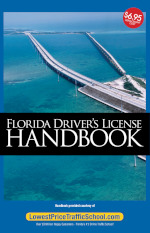Pass Your DMV Test the 1st Time - Guaranteed!
DMV Test Prep Course
Are you getting your Florida learner's permit or driver's license for the first time?
Prepare from the DMV Exam online! Don't spend hours studying the DMV Handbook when you can study online with our Guaranteed DMV Prep Course.
It's like having the answers BEFORE you take the DMV Exam!
Easily learn the answers to the Road Signs and Road Rules Tests, plus get detailed explanations.
Money-back guarantee. Complete our prep course and you will pass your DMV written exam your first time or we'll refund your money for the cost of the course!
Get the Learner's Permit Package and Save 29%
Learner's Permit Package
Take your course today and get your certificate in hours!
Our Learner's Permit package includes all of the coursework required to obtain your permit.
New drivers are required to take the Florida Traffic Law & Substance Abuse (TLSAE) course before taking the DMV written test. With you get this package, you can take this required course online, then take a practice DMV exam that will prepare you to pass the test the first time - guaranteed. Once you complete the practice exam, you'll proceed to the official DMV written exam online. All of this can be completed online in just one day.
*Plus State of Florida Assessment Fee & Provider Processing Fee, Convenience Fee, and/or ADLTS Fee as applicable More Info
Our Package for Parents & New Drivers
Ultimate Value Package
Take your course today and get your certificate in hours!
Parents can now be fully involved in this exciting time for teens. Our Ultimate Value Package offers extras for parents that can help prepare your child for the dangers of driving.
See Full Package Details- Online 4-Hour Drug & Alcohol (TLSAE) Course (Required) more info
If you are getting your drivers license for the first time, the State of Florida requires all applicants to complete and pass a learners permit course called the Traffic Law and Substance Abuse and Education (Drug and Alcohol Course) course. You are required to complete this course before you apply for your drivers license.
- Get the Package and Save!Enroll Now
- Just Get the CourseEnroll Now
- Online DMV Written Exam for Learner's Permit (Required) more info
In cooperation with Florida DHSMV regulations, students are permitted to take the DMV Exam online. This should greatly reduce the amount of time you spend in the Drivers License Office to get your Learner's Permit...up to several hours or even days waiting for an appointment!
- Get the Package and Save!Enroll Now
- Just Get the ExamEnroll Now
- Practice Tests & Prep Course for DMV Written Exam (Recommended) more info
Recommended course that prepares teens for the DHSMV written exams and includes both "Rules of the Road" and "Road Signs" practice tests.
- Get the Package and Save!Enroll Now
- Just Get the CourseEnroll Now
- Safe Driving Teen Monthly Bulletin (Recommended) more info
The Safe Driving Teen articles emphasize judgment errors and mistakes made by other teens, and the consequences of those mistakes. Additionally, valuable information is provided that will help to improve their knowledge and driving skills.
- Driver Education Handbook for Parents (Recommended) more info
This Handbook is designed to be a teaching tool for parents who are concerned with their teen's driving safety and understand the value of quality instruction. All the items your teen will be tested on when they go to take the DMV driving test to get their regular license are covered (see the Regular Drivers License Checklist or the Learner's Permit Checklist) in the Handbook.
- Parent-Teen Driving Contract (Recommended) more info
Create your own customized Parent-Teen Driving Contract online based on the recommendations from the Driver Education Handbook for Parents.
Order Now Ultimate Value Package - Your Price: $89.95
*Plus State of Florida Assessment Fee & Provider Processing Fee, Convenience Fee, and/or ADLTS Fee as applicable More Info
DMV Handbook

Exclusive provider of the Official Florida Driver Handbook, 2003-2011. You can put your trust in us to provide a quality Driver's Ed course too!
Our experts are here to help
(800) 729-1997
Express Shipping
Take Your Course Today and Get Your Certificate in Hours!
New Driver Resources
COURSEWORK & INFO
- Drug & Alcohol Course
- DMV Handbook
- DMV Exam Online
- Free DMV Practice Tests
- Florida Graduated Driver's License Guide
- How to Get a Florida Learner's Permit



